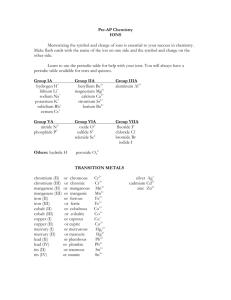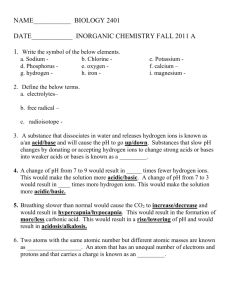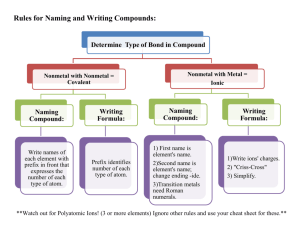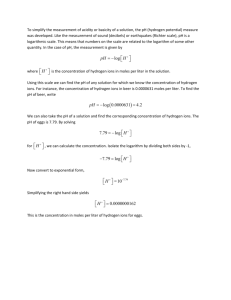learning the common ions
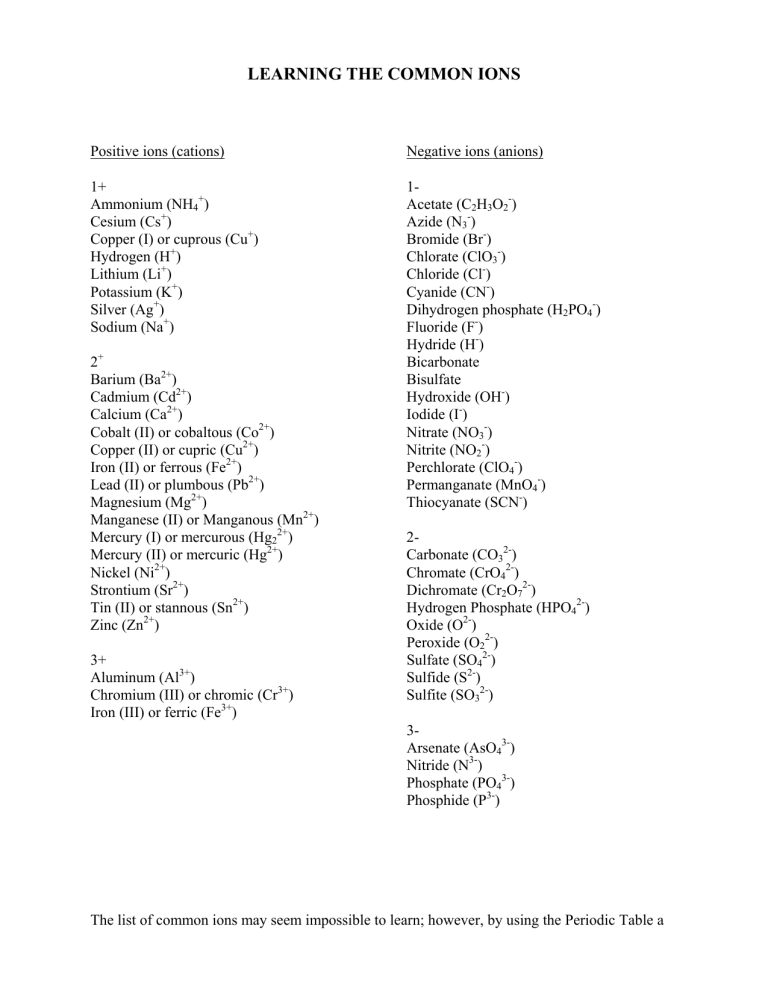
LEARNING THE COMMON IONS
Positive ions (cations) Negative ions (anions)
1+ 1-
Ammonium (NH
4
+
Cesium (Cs
+
Copper (I) or cuprous (Cu
+
Hydrogen (H
+
Lithium (Li
+
(Cl
-
)
Potassium (K
+
Silver (Ag
+
Sodium (Na
)
+
Dihydrogen phosphate (H
2
PO
4
-
)
(F
-
) Fluoride
Hydride (H
-
)
)
2
+
Bicarbonate
Barium (Ba
2+
Cadmium (Cd
) Bisulfate
2+
Calcium (Ca
2+
Cobalt (II) or cobaltous (Co
2+
Copper (II) or cupric (Cu
Iron (II) or ferrous (Fe
2+
2+
3
-
2
-
4
-
Lead (II) or plumbous (Pb
2+
Magnesium (Mg
2+
Manganese (II) or Manganous (Mn
2+
)
(SCN
-
)
Mercury (I) or mercurous (Hg
Mercury (II) or mercuric (Hg
Nickel (Ni
2+
2
2+
2+
) 2-
3
2-
4
2-
Strontium (Sr
2+
Tin (II) or stannous (Sn
Zinc (Zn
2+
2+
) Hydrogen Phosphate (HPO
4
2-
)
Peroxide (O
2
2-
)
Aluminum (Al
3+
Chromium (III) or chromic (Cr
3+
Iron (III) or ferric (Fe
3+
)
3-
Arsenate
4
3-
)
Nitride (N
3-
)
Phosphate (PO
4
3-
)
Phosphide (P
3-
)
The list of common ions may seem impossible to learn; however, by using the Periodic Table a
sizable chunk of the list is easily conquered.
Each row is called a period ; whereas, each column is referred to as a group . Group has similar chemical properties mainly because of the electrons in their outer shell.
Each atom wants eight electrons in its valence shell (outer-most shell). This is the most stable structure of the atom. Thus Group 8 A, the Noble Gases, all have eight electrons and rarely react. The other elements will either gain electrons or lose their electrons to gain a full valence shell.
The Method
First of all, photocopy the list given in class by your professor, or photocopy the list in your book.
* Now by using a highlighter, pencil, or color coding, cross out the following groups:
The negative ions:
Group 7 A: F, Cl, Br, I and At are -1.
Group 6 A: O, S, Se and Te are -2.
Group 5 A: N, and P are -3.
All these negative ions have the ending "-ide".
In addition, hydrogen can be -1 (and, thus, "hydride").
The positive ions:
Group 1 A: The first column is + 1 charge. That takes care of Li, Na, K, Rb, CS, and Fr.
Group 2 A: The following are + 2 charge: Be, Mg, Ca, Sr, Ba, and Ra.
Group 3 A: Alumninum is +3.
Hydrogen is an element that is either +1 (and simply "hydrogen") or -1 (hydride).
The remaining positive ions to be learned (preferably using notecards) are the Transition metals:
+1 Ag (Silver)
+2 Cd (Cadmium), Ni (Nickle), and Zn (Zinc)
Ammnonium (NH
4
+
)
Hydronium (H
3
O
+
)
2
The remaining electropositive elements are denoted with the Roman numerals I, II, and III.
By learning the charge and names of the negative ions thoroughly, the correct positive charge number can be derived. eg. Fe Cl
3
Chlorine is -1 and there are 3, so if Fe Cl 3 is neutral (no charge), then Fe must be + 3 and thus
Fe (III) or Iron III.
What now? More on the negative ions.
Very common negative ion pairs:
The following pairs demonstrate the "-ate" versus "-ite" [a simple difference in the number of oxygen atoms].
Sulfate (SO
4
and Sulfite (SO
3
) are -2.
Nitrate (NO
3
) and Nitrite (NO
2
) are -1.
Perchlorate (ClO
4
) and Chlorate (ClO
3
) are -1.
The following are -3 and HAVE 4 oxygens:
Arsenate AsO
4
3-
Phosphate PO
4
3-
Oxygen is mostly -2 except:
Hydroxide is -1. Since oxide is -2 then hydrogen is + 1. (OH
-
)
However, peroxide is also -2 which means each oxygen is -1! (O
2
2-
)
NOTE: Carbonate is CO
3
2-
. Which means oxygen is -2 which would make Carbon +4. Carbon has 4 electrons! It could either obtain 4 or lose 4 since it is directly in the middle!
Strange looking ones!
-1 Cyanide CN
Azide N
3
-1
Acetate C
2
H
3
O
2
-1
Thiocyanate SCN -1
CrO
4
Cr
2
O
7
2-
2-
Chromate
Perchromate
-2
-2
MnO
4
-
Permangate -1
A further word:
3
Since Phosphate is -3 adding one hydrogen (+1) would give Hydrogen phospate WITH a charge of -2.
One more hydrogen gives Dihydrogen phosphate WITH a charge of -1.
The following have "historical" names also:
Bicarbonate: Add one hydrogen (+1) to Carbonate (-2) to get HCO3-.
Bisulfate: Add one hydrogen (+1) to Sulfate (-2) to get HSO4-.
THIS IS NOT A COMPLETE LISTING OF KNOWN IONS BUT SHOULD BE A START
AND HOPEFULLY LOGICAL TOOL TO ABSORB, UTILIZE, AND LEARN SOME
CHEMISTRY.
Revised: Spring 1995
Edited by: Senovio R. Rodriguez, Spring 1995
Source: Brown, LeMay, Bursten 5th Ed. 1991, Chemistry: The Central Science
STUDENT LEARNING ASSISTANCE CENTER (SLAC)
Texas State University-San Marcos
4

